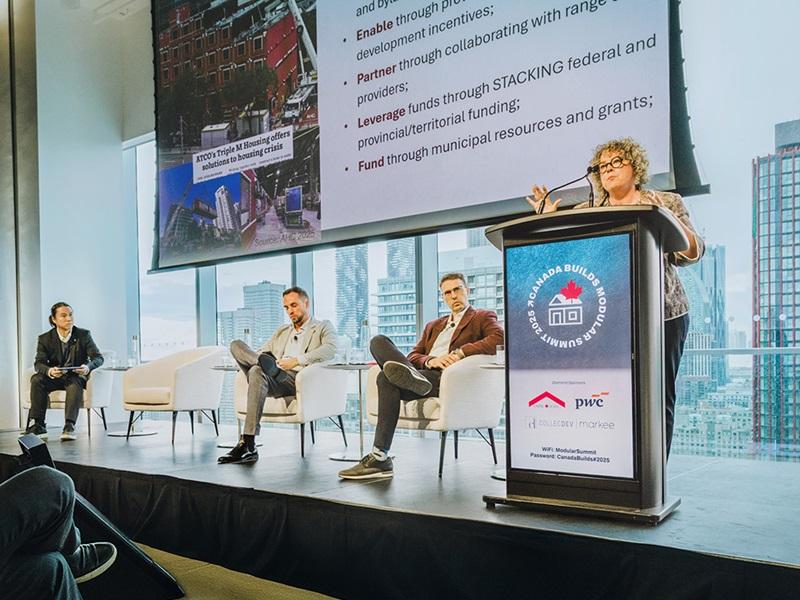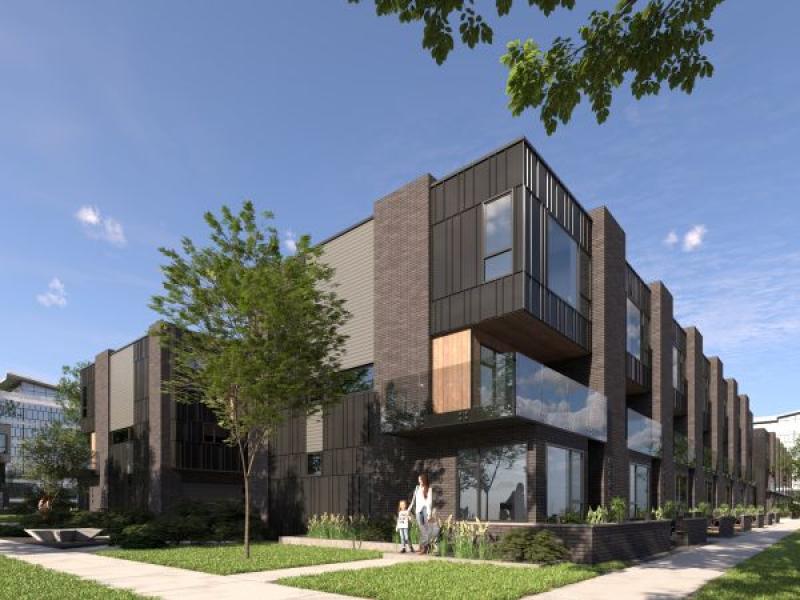
Developers are forging partnerships in the face of increasingly challenging building conditions, and by combining their efforts and sharing risks, they’re finding ways to bring projects to market.
“Builders working together is a trend on the rise, and it will continue, because together they’re alleviating some of the pressures,” Kathy Di Silvestro, president of Crystal Homes, told RENX Homes.
“COVID and inflation have driven up prices for us, but working together helps reduce some of those overhead prices. Through COVID, all builders were forced to work closely together and it’s had a lasting positive outcome where we’re able to provide housing quickly, and at lower prices than we would otherwise be able to, because we’re forced to.”
Crystal Homes has had a longstanding partnership with Fernbrook Homes, including land transactions and co-developments like, most recently, NUVO Condos in Oakville.
As far back as 2013, they collaborated on Grand River Woods in Cambridge.
Working together can save time, and money
“Cost savings are significant but time savings are also significant,” Di Silvestro continued. “Even if we’re two separate landowners side by side, we’ll process our applications together for convenience. The benefit to us is the time saved, which is money saved.”
Di Silvestro says exorbitant land costs have become prohibitive for an increasing number of developers and that has necessitated partnerships, but it isn’t the only reason joint ventures have become commonplace. With Canada’s population growing at record pace, municipalities are scrambling to plan for surplus housing demand.
And developers are helping expedite the process by pooling their resources, Di Silvestro said, because it ultimately shortens development timelines.
“Demand for housing in Ontario continues to rise and the municipalities can’t keep up, so what (we as developers) are doing is funding our own research and conforming to whatever their requirements are for certain things — neighbourhoods, schools, parks — and we’re helping put those pieces together so (municipalities) only have to worry about reviews rather than hire outside consultants,” Di Silvestro said.
West Coast perspective

Major cities in British Columbia are hardly different than Greater Toronto in this area. Kevin Liu, CEO of Vancouver's PACK Buildings Inc., was approached by a construction contractor to finance development of an oceanside parcel of land in Victoria.
Upon visiting the site, Liu struck a deal with the contractor on what’s become West Bay Crest, a seven-unit luxury townhouse development, with PACK Buildings the majority stakeholder.
“It’s beneficial to partner with another firm, especially for new players,” Liu said, “but it evolves into sharing networks and building trust.”
PACK Buildings isn’t a stranger to partnerships; it has had an extensive relationship with Gryphon Development. Together, they have developed Gryphon House, Gryphon Nova, and Oak & 67.
“In a partnership, there needs to be a shared vision, but it needs to be competitive for both parties,” Liu said.
There are other reasons for partnerships too.
Metropia, Capital, RioCan JV on 65-storey 11 Yorkville
11 Yorkville is a venture between Metropia, RioCan Living and Capital Developments which is slated to begin occupancy in December. According to Samuel Frum, president of Metropia, the 698-unit, 65-storey tower, is “a greater outcome than any of us would have done alone.”
“We're all financially equipped companies that could do big projects on our own, but we think bringing multiple groups together allows us to have the best execution and share ideas,” Frum said. “Eleven Yorkville is being constructed on time and on budget, thanks to oversight from three great builders.
"What’s great about this partnership is we each have our own areas of expertise, and we’ve combined them.”
Plaza Corp. is a builder that typically provides covenant in partnerships. Chief operating officer Scott McLellan hasn’t noticed much growth in joint ventures between developers; rather, he says project launches have cratered in the last couple of years.
But he isn’t surprised some developers would enter partnerships to make the financials work.
Echoing Frum, he also says there are a variety of reasons developers partner on projects, noting that Plaza Corp. is jointly developing a condominium in Markham with Sunny Communities.
The project’s final incarnation will soon be determined, which McLellan expects will be in the ballpark of 600 condos across two towers, each between 20 and 30 storeys, to go along with 160 stacked townhouses.
“The reason we’re doing this deal is we’re primarily a high-rise builder and Sunny is a low-rise builder, and they had the piece of land and went out and looked for a partner whose expertise best fit what they’re trying to do,” McLellan said. “We know each other’s skill sets, but Sunny has a long history in Markham, which is where this project is.
“As partners, we respect each other on how to best utilize our respective strengths.”
Partnerships can also sometimes be synonymous with relationships, McLellan added.
“I’ve been in the business for over 30 years, so I’ve gotten to know everybody, and there are certain developers out there that, if we had the opportunity to work together, we’d jump at it,” he said.
“Sunny is certainly one of them. I’ve known the principal at Sunny for over 30 years.”










